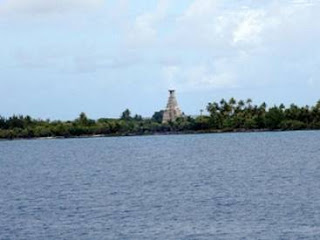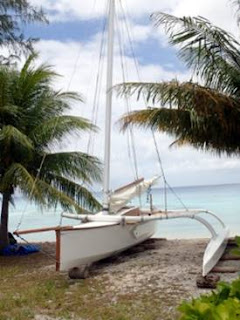Located 280 miles from Tahiti, Fakarava is the second largest atoll in the Tuamotu Archipelago. It is over 37 miles long and 15.5 miles wide, and was once the capital, before the government moved to Rangiroa. A total of 800 residents live here, mostly in the northern part of the island at Rotoava.
If you had attempted to come here, let's say, back in the 1600's, you would have found the most dangerous archipelagos on earth. The Portuguese and the French found that out by losing 30 vessels on the coral reefs over the centuries. It took three hundred years to chart the 78 atolls, but considered them as having no economic value at that time.
French and British missionaries arrived, built churches, and encouraged the natives to plant coconut trees for the meat and the copra. In the 1850's, the golden age of mother-of-pearl buttons became a thriving industry. There was a huge European demand, until eventually, plastic replaced them. What's the biggest industry here today? Pearl farming….in the 1960's, it took off like the gold rush in California, and has been going strong ever since.
Isolated from the rest of the world, rare forms of flora and fauna exist here. Especially in the lagoon waters. A hunting kingfisher, tuamotu palms, squills, and sea cicadas can be found here. For the divers among us, they can see grey and hammerhead sharks, manta rays, grouper, barracudas, turtles, and dolphins.
There are to passes into this lagoon. The one on the north shore is the largest in all of French Polynesia. It is called Ngaruae Pass and measures 2,624 feet from end to end. That is the one we came through this morning. The other opening is in the south and is called Tetamanu, equally great for the divers.
Fakarava has been a UNESCO Biosphere Reserve for its rich ecosystem since 2006. Unlike Rangiroa, this atoll offers a very long stretch of beachfront, although narrow, it makes accessing the lagoon water quite easy. The string of coconut palms and sea pines provide much needed shade along the way.
We were here only once, about three or four years ago, while on a similar cruise on the Statendam. It always helps to know the layout before you go ashore. Today we left the ship around 10am, well after the tender ticket line was over. It was going to be another sweltering day, even though there was somewhat of a breeze.
Lots of people went to shore, since there are only two ports left on this trip. This would be the last chance for people to swim in the tropical waters of the Pacific Ocean before getting back to San Diego. The waters in Nuku Hiva are much colder with no real beaches.
Other things to do here included two tours. One was a 1 ½ hour snorkel swim at the Coral Garden area of the lagoon for $120. While the other choice was a one tank dive for 2 hours for $130. You have to be certified to do this type of tour.
Another way to get around was by renting bikes. We saw the sign at the pier landing….a two hour rental was $15. But you still have to remember to be careful and know your capabilities. While we were on our walk, a German couple we have gotten to know, passed by…..the fellow bandaged up from his wrist to his elbow. Apparently he fell yesterday while they were riding bikes in Rangiroa. He said that coral road was slippery, and he skidded on some palm leaves. Coral cuts can be nasty and painful, as he found out. They were being most careful today, and packing antiseptic and bandages just in case. Most all the locals drive scooters or small cars. And few walk.
There is an interesting small Catholic church on the main road by the name of Pariosse St. Jean de la Croix. Not the oldest church on the atoll, it is much more modern. On the southern part of the atoll, there is the first church that was built in 1874. It is constructed entirely of coral. Wish we could have seen it, but it takes 1 ½ hours to get there by boat. Behind the Catholic church is a cemetery that dated back to the missionary days.
Back to the road, we passed by some tables with souvenirs, mostly island jewelry. Some of the pieces were being made right before our eyes. We did pick up a set made with the tiniest seashells we have ever seen. There were a few small shops, a couple of food stores, artist studios, and the simplest of eateries. More like sandwich stands. What drives us nuts is when the ship's information has hotels or restaurants listed that are no longer there, or open late for dinner, not lunch. They do need to update their exploration booklets.
There is one mini-resort that we went to the last time we were here. It is called the Pearl Havaiki Resort. The sign has since disappeared at the roadside, but we knew to follow the dirt path to the end of the dirt road. There is a snack shack on the property called Le Snack Requin, where you order your food at the window, then pick it up when it's done. Sort of fast food isand-style, only much better. A covered sandy patio is where we sat, wishing for a breeze, while watching the lagoon's activity. We had a shared cheeseburger and fries, along with Hinano beers.
This is the same place we ate the last time we were here. At the time, we watched three people eating their burgers at a table and chairs that were placed in the water….about waist deep. Another guest was standing on a small boat per nearby, tossing French fries in the water. He was attracting sharks, one of which began circling the table where the diners were eating. They never saw the shark, so we did not want to panic them, as we understand they are harmless to people. Glad it was them, and not us. Eventually, it swam away, and they were never aware of it. Yikes…….
We took our time walking back, running into our favorite tablemates, who were swimming in the cool waters along the beach. They had the right idea, taking advantage of the postcard-perfect white sands and shady palm trees. Living in Alabama and England, they don't often get the chance to dip their toes into the mighty Pacific Ocean.
The landing pier had cleared out by the time we got there. Gone were the native greeters and the crowds of folks looking for the last chance to buy South Pacific jewelry. The choices will be limited when we reach the Marquesas in two days.
The tenderboat left right after we boarded, and thankfully so. It was so warm, and the breeze was almost gone by now, Getting back to the coolness of the ship sure sounded good. So did a cool, refreshing shower.
Since the drift of the ship's stacks has been so nasty, the sail away celebrations have remained on the lower promenade deck. We could hear the music drift up to deck eight and nine as we made our way to the Seaview Pool. It appeared that the crew had recently begun deep cleaning up on deck nine aft, as the imitation teak decking looked much cleaner up here. Back down on the lower deck, that was not the case. We have never seen the decking so stained and spotty. Assuming that the decks would be power-cleaned at night, we were wrong in our thinking. After sunset, the deck fellows have been stacking all of the lounges, and covering them. Now we realize they are doing the extra work to keep them clean. By leaving the lounges out all night, they were getting covered with the staining soot. Wonder how many people have gotten their clothes ruined from sitting on those lounges? It is hard to see until it is too late.
Anyway, we stayed out back for almost two hours, watching the sail out of the lagoon. We did have the help of a pilot through this one. Expecting the rush of the water, we were almost disappointed since the bumpy ride did not happen. Smoother than the last sail out, it must have something to do with the tides and the depth of the channel.
We were rewarded once out to sea, when we spotted the dorsal fins of dozens of dolphins, feeding in our wake. Hundreds of birds gathering over the slower bottlenose dolphins as they barely broke the surface as they fed. Very few of the folks even saw them. This was one time you needed a good camera or even binoculars, since these dolphins did not follow the ship, but stayed far back.
Ten minutes before 6pm, the sun set on the horizon, giving us yet another South Seas thrill. We are going to miss sharing these special sunsets when we get home, since a big mountain blocks our view at home. We are located on the "morning" side of the mountain, so we get the good sunrises instead.
Everyone was present at dinner, tired from a long, warm and humid day, but never too tired for a good meal. We had the veal piccata with spaghetti with marinara sauce, always a favorite of ours. Not sure how many of us will be able to stay up for the show, String Fever, a duo couple who add humor to their musical talents.
Oh yes, tonight we begin the process of turning our clocks ahead as we head on an easterly direction. This time we put them ahead ½ hour, because the Marquesas are on that time difference. The good news: we have a much-needed day at sea tomorrow.
Bill & Mary Ann





















































































